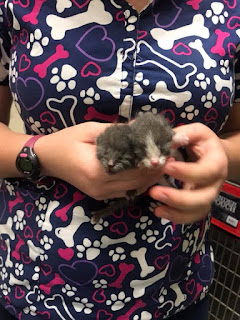These kittens sure are growing up fast! Pip and Squeak are now almost 4 weeks old and are weighing in at around 500grams (Aprox 17.5 ounces, or just over 1 pound). They are completely weaned off of the bottle, and are getting fed gruel about 7-8 times a day. They've started to show a little interest in babycat kibble, so I don't think it will be long before these two are eating on their own!
The only downside to this step of their development is that they are going to the bathroom on their own, which means they are pooping on EVERYTHING (including each other!) Most days they are getting at least three baths, and the amount of dirty laundry is staggering! They have little litterboxes available in both their playpen and their crate, but they haven't quite got the hang of using them yet.
Bathing kittens requires some extra-special care; you have to make sure that their little heads never go under the water, and they have to be COMPLETELY dried off afterwards so they don't get sick. Even at this young age they've already decided that they do NOT like the water.
After their baths they both get wrapped up like tiny kitten burritos and get cuddled until they warm up and dry off.
After bath time comes play time, and then nap time. Then they wake up, eat more, poop more, and the whole process starts over again.
The only downside to this step of their development is that they are going to the bathroom on their own, which means they are pooping on EVERYTHING (including each other!) Most days they are getting at least three baths, and the amount of dirty laundry is staggering! They have little litterboxes available in both their playpen and their crate, but they haven't quite got the hang of using them yet.
Bathing kittens requires some extra-special care; you have to make sure that their little heads never go under the water, and they have to be COMPLETELY dried off afterwards so they don't get sick. Even at this young age they've already decided that they do NOT like the water.
After their baths they both get wrapped up like tiny kitten burritos and get cuddled until they warm up and dry off.
After bath time comes play time, and then nap time. Then they wake up, eat more, poop more, and the whole process starts over again.





































